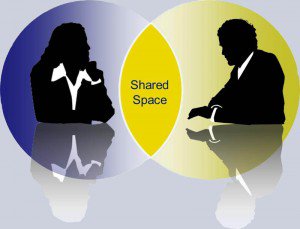The Business Interview Is An Interaction
We continue our series of articles about client and stakeholder interviewing to inform and build alignment around important projects and initiatives. In our Advance Update, Conducting Stakeholder Interviews: Creating a Shared Space, we introduced the concept of shared space as it relates to conducting interviews. In this article we review that concept and discuss how it relates to the five most important actions for conducting stakeholder interviews.
Creating Shared Space
Creating shared space with an individual or group is about focusing on the bigger picture and the common good you can create together, not just on your own agendas. Everything we do before and during an interview is an opportunity to build shared space.
 Not surprisingly, the five most important actions when conducting stakeholder interviews all have to do with creating shared space with those you interview. If you pay attention to these things, you will notice results like:
Not surprisingly, the five most important actions when conducting stakeholder interviews all have to do with creating shared space with those you interview. If you pay attention to these things, you will notice results like:
- The client or stakeholder spends extra time with you in the interview.
- They become an advocate who is willing to support your project.
- You jointly “own” and share in the initiative and outcome.
- You established a more personal connection with your client or stakeholder that can provide you with an open door and a place to go for help in the future.
- Both of you enjoyed the interview and found the whole experience professionally enriching.
- You have a new sense of confidence about interviewing others.
Here are the five most important things to do when engaging in stakeholder and client interviewing.
1) Connect Your Interview With the Business
Do your homework before the interview to assess how your project or initiative will impact the part of the business managed by the person you will interview. Anticipate and be prepared to articulate the benefits the project will have, but also be prepared to discuss major challenges and potential areas of resistance. As you conduct the interview, create shared space by letting him know through your questions that you understand his business and would like to know more.
2) Connect Your Goals With Their Goals
You don’t want to be seen as trying to do something to someone’s business that will have no perceived benefit. Instead, look for ways to connect your project goals with her business goals. For example, if she needs to reduce her costs, show her how this project will help do that after the initial implementation is completed. The more you build alignment between your goals and hers, the more you create shared space.
3) Question to Learn AND Inform
Of course you are conducting the interview to learn important things that will help your project be successful. However, you must also inform those you interview. To do this, avoid a lot of “telling.” It tends to erode shared space and can turn your interview upside down. Instead, inform through your questions. Much of what you typically need to tell those you interview can be phrased in the form of a question. Allow yourself an introductory period to describe the project, if necessary. Then stay with questions as much as possible.
4) Listen to the “Other Conversation“
We discussed the importance of the Other Conversation in our recent  Advance Update. This is the unspoken conversation going on in parallel with the verbal one. The Other Conversation will largely determine the outcome of your interview. It is about creating shared space (or not). Watch for verbal cues and body language that will tell you how the person feels about the interview, each question, and their working relationship with you.
Advance Update. This is the unspoken conversation going on in parallel with the verbal one. The Other Conversation will largely determine the outcome of your interview. It is about creating shared space (or not). Watch for verbal cues and body language that will tell you how the person feels about the interview, each question, and their working relationship with you.
5) Stay Present and “Dance“
Bring it all together by staying present in your interview and “dancing.” That doesn’t mean that you should literally get out of your chair and do the Two Step – it could be fun but may not end well. Rather, while following the Other Conversation, use the other tools and techniques discussed above to conduct the interview while building shared space. This is a dance of sorts with the person you are interviewing. One move follows and builds upon the previous. You blend the flexibility to go with the flow of the conversation with your prepared strategy for the interview. The result is knowledge, relationship, and a great outcome.
I hope this article has been helpful. Please respond with your reactions, questions and experiences.
If your team would like more in-depth help with interviewing skills training, we offer a one-day workshop, The Connected Interviewer™. Or, contact us to discuss your specific needs.
